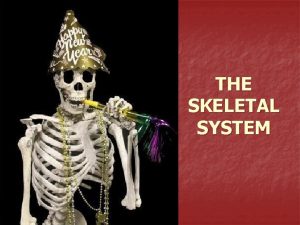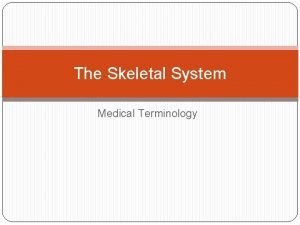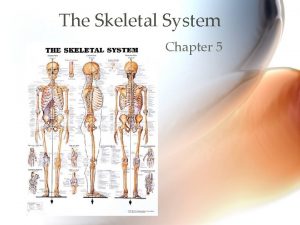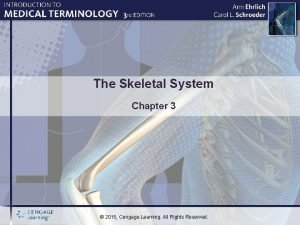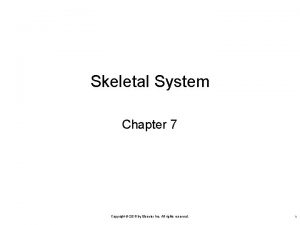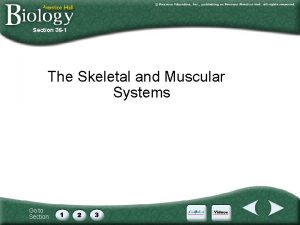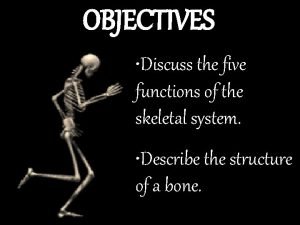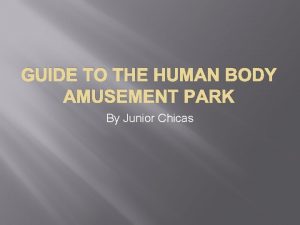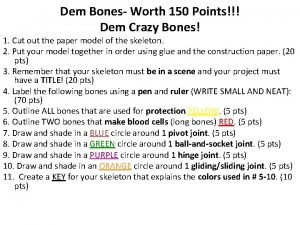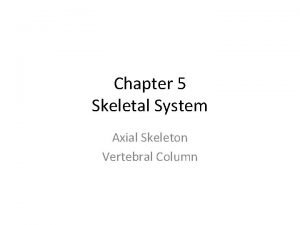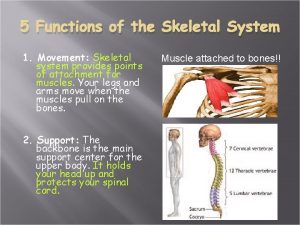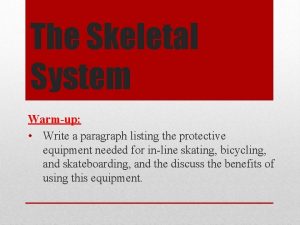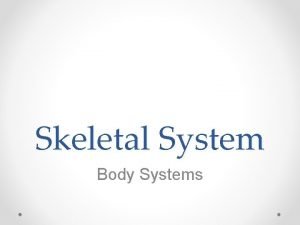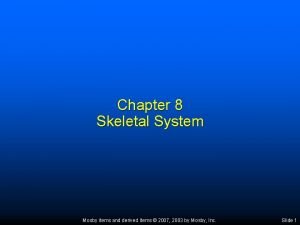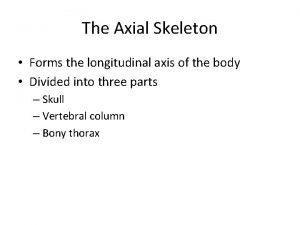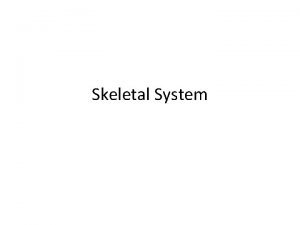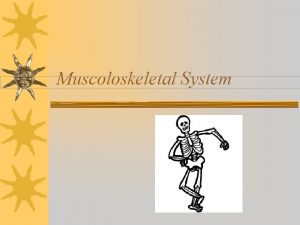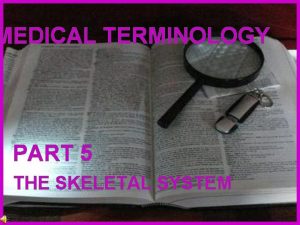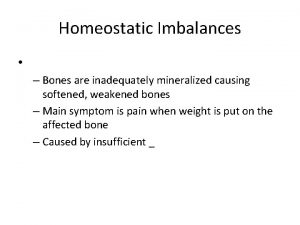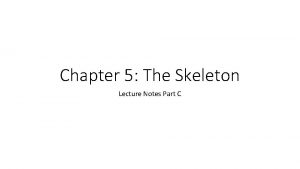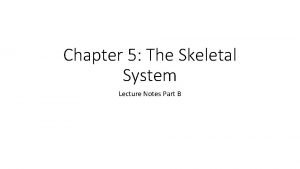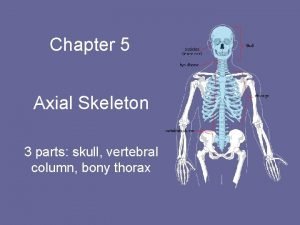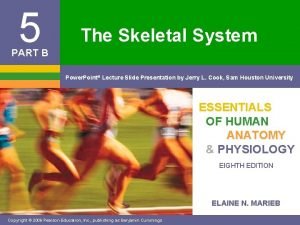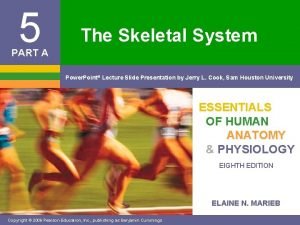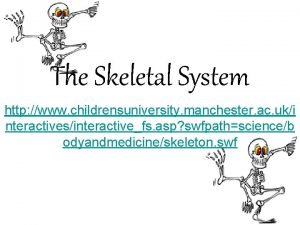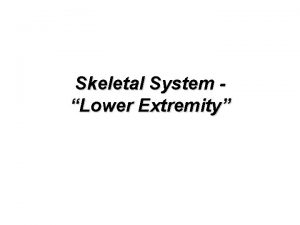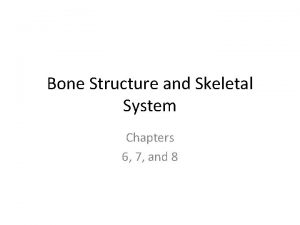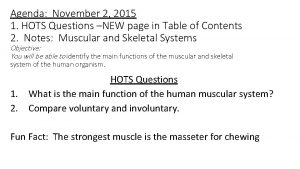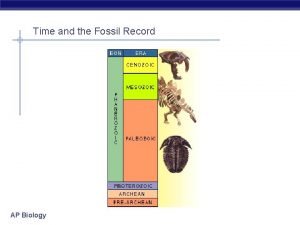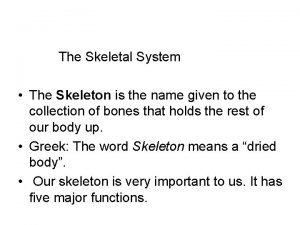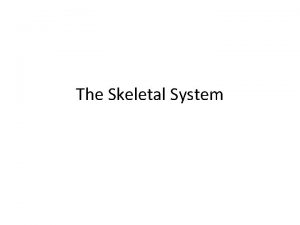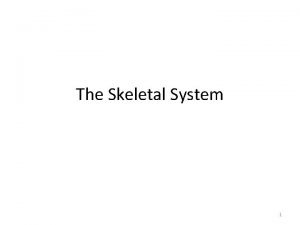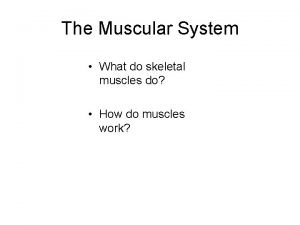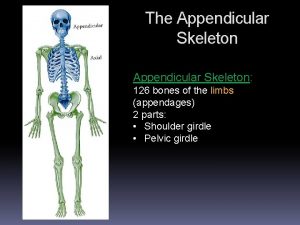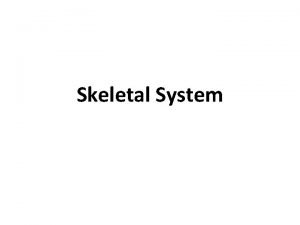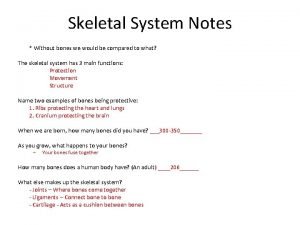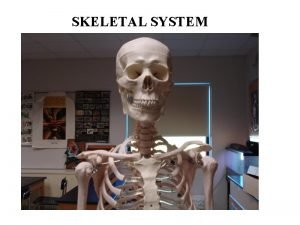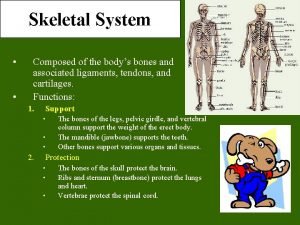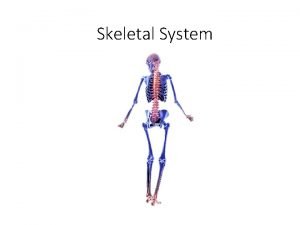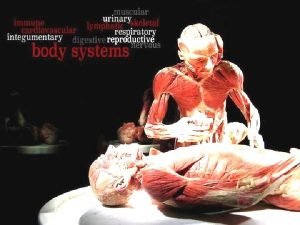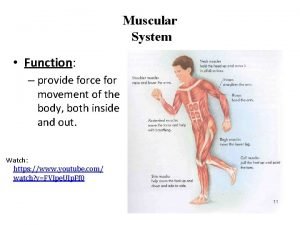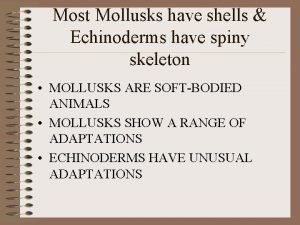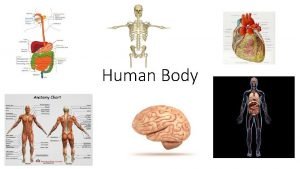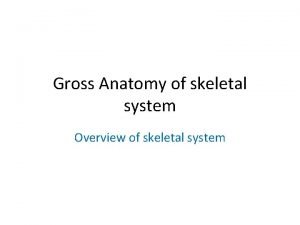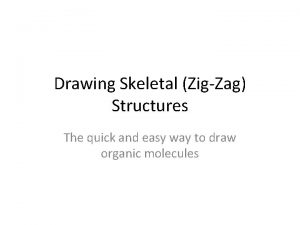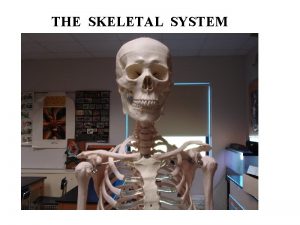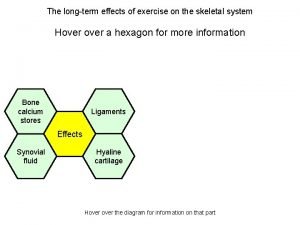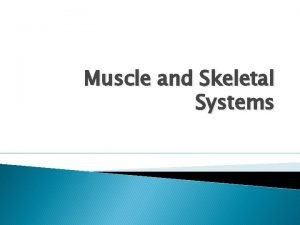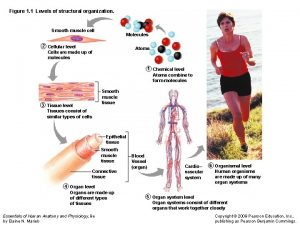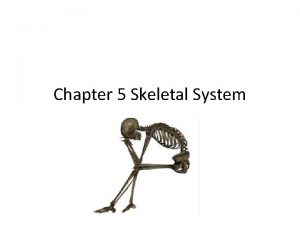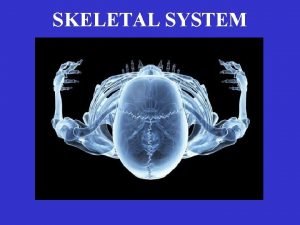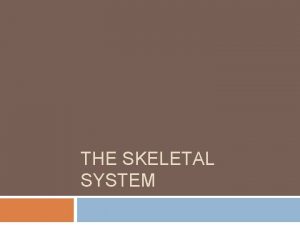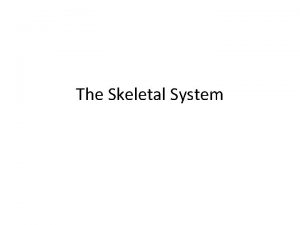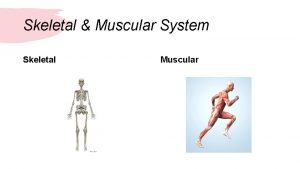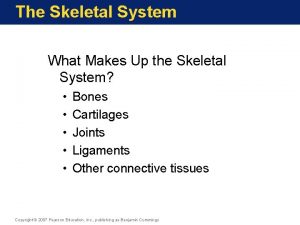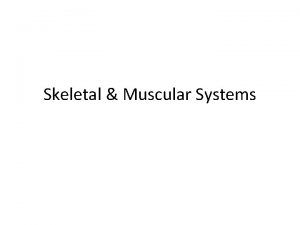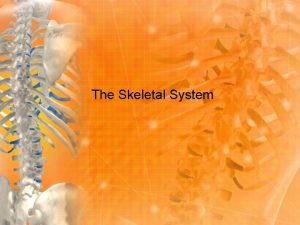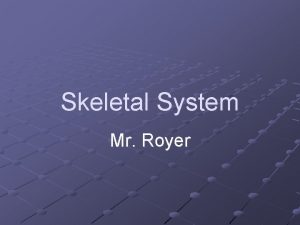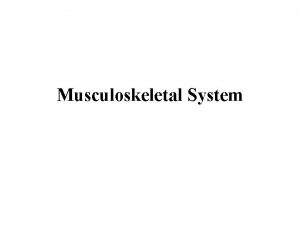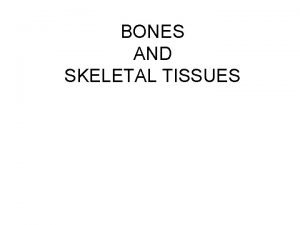The Skeletal System What Makes Up the Skeletal




































































































- Slides: 100

The Skeletal System What Makes Up the Skeletal System? • • • Bones Cartilages Joints Ligaments Other connective tissues Copyright © 2007 Pearson Education, Inc. , publishing as Benjamin Cummings

The Skeletal System What are the Functions of the Skeletal System? • Support against gravity • Storage • Calcium, phosphorous • Fat • Blood cell production • Protection of soft internal organs • Leverage for muscle action Copyright © 2007 Pearson Education, Inc. , publishing as Benjamin Cummings

The Structure of Bone What is Bone (Osseous Tissue)? • Specialized cells • 2% of bone weight • Strong flexible matrix • Calcium phosphate crystals • Two-thirds of bone weight • Collagen fibers Copyright © 2007 Pearson Education, Inc. , publishing as Benjamin Cummings

The Structure of Bone What is the Macroscopic Features of Bone? • General shapes of bones • Long bones (e. g. , humerus) • Short bones (e. g. , carpal bones) • Flat bones (e. g. , parietal bone) • Irregular bones (e. g. , vertebra) Copyright © 2007 Pearson Education, Inc. , publishing as Benjamin Cummings

The Structure of Bone Shapes of Bones Figure 6 -1

The Structure of Bone What are the Features in a Long Bone? • Diaphysis (shaft) • Compact (dense) bone • Marrow cavity • Epiphyses (ends) • Spongy (cancellous) bone • Articular cartilage • Periosteum (covering) • Endosteum (lining) Copyright © 2007 Pearson Education, Inc. , publishing as Benjamin Cummings

The Structure of Bone The Structure of a Long Bone Figure 6 -2

The Structure of Bone What is the Microscopic Features of Bone? • Periosteum • Outer fibrous layer • Inner cellular layer • Osteocytes • Within lacunae (holes) in matrix • Between lamellae of matrix Copyright © 2007 Pearson Education, Inc. , publishing as Benjamin Cummings

The Structure of Bone What is the Microscopic Features of Bone • Osteon—Basic functional unit of compact bone; columnar in shape • Concentric layers of osteocytes • Concentric layers of matrix (lamellae) • Central (Haversian) canal • Axial tunnel for blood vessels • Perforating canal Copyright © 2007 Pearson Education, Inc. , publishing as Benjamin Cummings

The Structure of Bone Structure of a Typical Bone Figure 6 -3(a)

The Structure of Bone Structure of a Typical Bone Figure 6 -3(b)

The Structure of Bone What are the Cells in Bone? • Osteocytes • Mature bone cells between lamellae • Osteoclasts • Source of acid, enzymes for osteolysis • Osteoblasts • Responsible for osteogenesis (new bone) Copyright © 2007 Pearson Education, Inc. , publishing as Benjamin Cummings

Bone Formation and Growth Intramembranous Ossification • Ossification—Process of converting other tissues to bone Copyright © 2007 Pearson Education, Inc. , publishing as Benjamin Cummings

Bone Formation and Growth Bone Formation in 16 -Week-Old Fetus Figure 6 -4

Chondrocytes at the center of the growing cartilage model enlarge and then die as the matrix calicifies. Newly derived osteoblasts cover the shaft of the cartilage in a thin layer of bone. Blood vessels penetrate the cartilage. New osteoblasts form a primary ossification center. The bone of the shaft thickens, and the cartilage near each epiphysis is replaced by shafts of bone. Blood vessels invade the epiphyses and osteoblasts form secondary centers of ossification. Articular cartilage Enlarging chondrocytes within calcifying matrix Epiphysis Diaphysis Epiphyseal cartilage Marrow cavity Primary ossification center Bone formation Blood vessel Marrow cavity Blood vessel Secondary ossification center Cartilage model Copyright © 2007 Pearson Education, Inc. , publishing as Benjamin Cummings Figure 6 -5 1 of 6

Chondrocytes at the center of the growing cartilage model enlarge and then die as the matrix calicifies. Enlarging chondrocytes within calcifying matrix Cartilage model Copyright © 2007 Pearson Education, Inc. , publishing as Benjamin Cummings Figure 6 -5 2 of 6

Chondrocytes at the center of the growing cartilage model enlarge and then die as the matrix calicifies. Newly derived osteoblasts cover the shaft of the cartilage in a thin layer of bone. Enlarging chondrocytes within calcifying matrix Epiphysis Diaphysis Bone formation Cartilage model Copyright © 2007 Pearson Education, Inc. , publishing as Benjamin Cummings Figure 6 -5 3 of 6

Chondrocytes at the center of the growing cartilage model enlarge and then die as the matrix calicifies. Newly derived osteoblasts cover the shaft of the cartilage in a thin layer of bone. Blood vessels penetrate the cartilage. New osteoblasts form a primary ossification center. Enlarging chondrocytes within calcifying matrix Epiphysis Diaphysis Marrow cavity Primary ossification center Bone formation Blood vessel Cartilage model Copyright © 2007 Pearson Education, Inc. , publishing as Benjamin Cummings Figure 6 -5 4 of 6

Chondrocytes at the center of the growing cartilage model enlarge and then die as the matrix calicifies. Newly derived osteoblasts cover the shaft of the cartilage in a thin layer of bone. Blood vessels penetrate the cartilage. New osteoblasts form a primary ossification center. The bone of the shaft thickens, and the cartilage near each epiphysis is replaced by shafts of bone. Enlarging chondrocytes within calcifying matrix Epiphysis Diaphysis Marrow cavity Primary ossification center Bone formation Blood vessel Marrow cavity Blood vessel Cartilage model Copyright © 2007 Pearson Education, Inc. , publishing as Benjamin Cummings Figure 6 -5 5 of 6

Chondrocytes at the center of the growing cartilage model enlarge and then die as the matrix calicifies. Newly derived osteoblasts cover the shaft of the cartilage in a thin layer of bone. Blood vessels penetrate the cartilage. New osteoblasts form a primary ossification center. The bone of the shaft thickens, and the cartilage near each epiphysis is replaced by shafts of bone. Blood vessels invade the epiphyses and osteoblasts form secondary centers of ossification. Articular cartilage Enlarging chondrocytes within calcifying matrix Epiphysis Diaphysis Epiphyseal cartilage Marrow cavity Primary ossification center Bone formation Blood vessel Marrow cavity Blood vessel Secondary ossification center Cartilage model PLAY Endochondral Ossification Copyright © 2007 Pearson Education, Inc. , publishing as Benjamin Cummings Figure 6 -5 6 of 6

Bone Formation and Growth Appositional Bone Growth Figure 6 -6

Bone Formation and Growth What are the Requirements for Normal Bone Growth • Minerals • Calcium, phosphate • Vitamins • Vitamin D 3 • Vitamin C • Vitamin A • Hormones • Growth Hormone • Sex hormones, thyroid hormone, others Copyright © 2007 Pearson Education, Inc. , publishing as Benjamin Cummings

Bone Remodeling/Homeostasis What is the Role of Remodeling in Support? • Remodeling—Continuous breakdown and reforming of bone tissue Copyright © 2007 Pearson Education, Inc. , publishing as Benjamin Cummings

Bone Remodeling/Homeostasis Key Note What you don’t use, you lose. The stresses applied to bones during exercise are essential to maintaining bone strength and bone mass Copyright © 2007 Pearson Education, Inc. , publishing as Benjamin Cummings

Bone Remodeling/Homeostasis What is Injury and Repair? • Fracture—A crack or break in a bone Copyright © 2007 Pearson Education, Inc. , publishing as Benjamin Cummings

Immediately after the fracture, extensive bleeding occurs. Over a period of several hours, a large blood clot, or fracture hematoma, develops. Bone fragments An internal callus forms as a network of spongy bone unites the inner edges, and an external callus of cartilage and bone stabilizes the outer edges. Spongy bone Cartilage of internal of external callus The cartilage of the external callus has been replaced by bone, and struts of spongy bone now unite the broken ends. Fragments of dead bone and the areas of bone closest to the break have been removed and replaced. External callus Fracture hematoma Dead bone A swelling initially marks the location of the fracture. Over time, this region will be remodeled, and little evidence of the fracture will remain. New bone Periosteum Copyright © 2007 Pearson Education, Inc. , publishing as Benjamin Cummings Internal callus External callus Figure 6 -7 1 of 5

Immediately after the fracture, extensive bleeding occurs. Over a period of several hours, a large blood clot, or fracture hematoma, develops. Bone fragments Fracture hematoma Dead bone Copyright © 2007 Pearson Education, Inc. , publishing as Benjamin Cummings Figure 6 -7 2 of 5

Immediately after the fracture, extensive bleeding occurs. Over a period of several hours, a large blood clot, or fracture hematoma, develops. Bone fragments An internal callus forms as a network of spongy bone unites the inner edges, and an external callus of cartilage and bone stabilizes the outer edges. Spongy bone Cartilage of internal of external callus Fracture hematoma Dead bone New bone Periosteum Copyright © 2007 Pearson Education, Inc. , publishing as Benjamin Cummings Figure 6 -7 3 of 5

Immediately after the fracture, extensive bleeding occurs. Over a period of several hours, a large blood clot, or fracture hematoma, develops. Bone fragments An internal callus forms as a network of spongy bone unites the inner edges, and an external callus of cartilage and bone stabilizes the outer edges. Spongy bone Cartilage of internal of external callus The cartilage of the external callus has been replaced by bone, and struts of spongy bone now unite the broken ends. Fragments of dead bone and the areas of bone closest to the break have been removed and replaced. Fracture hematoma Dead bone New bone Periosteum Copyright © 2007 Pearson Education, Inc. , publishing as Benjamin Cummings Internal callus External callus Figure 6 -7 4 of 5

Immediately after the fracture, extensive bleeding occurs. Over a period of several hours, a large blood clot, or fracture hematoma, develops. Bone fragments An internal callus forms as a network of spongy bone unites the inner edges, and an external callus of cartilage and bone stabilizes the outer edges. Spongy bone Cartilage of internal of external callus The cartilage of the external callus has been replaced by bone, and struts of spongy bone now unite the broken ends. Fragments of dead bone and the areas of bone closest to the break have been removed and replaced. External callus Fracture hematoma Dead bone PLAY A swelling initially marks the location of the fracture. Over time, this region will be remodeled, and little evidence of the fracture will remain. New bone Periosteum Internal callus Steps in the Repair of a Fracture Copyright © 2007 Pearson Education, Inc. , publishing as Benjamin Cummings External callus Figure 6 -7 5 of 5

An Overview of the Skeleton What are the Bone Markings (Selected)? • • Tuberosity Condyle Trochlea Facet Fossa Foramen Sinus Copyright © 2007 Pearson Education, Inc. , publishing as Benjamin Cummings

An Overview of the Skeleton Surface Features of Bones Table 6 -1 (1 of 2)

An Overview of the Skeleton Surface Features of Bones Table 6 -1 (2 of 2)

An Overview of the Skeleton What are the Skeletal Divisions? • Axial skeleton • Skull • Thoracic cage and sternum • Vertebral column • Appendicular skeleton • Upper, lower limbs • Pectoral girdle • Pelvic girdle Copyright © 2007 Pearson Education, Inc. , publishing as Benjamin Cummings

An Overview of the Skeleton The Skeleton Figure 6 -8(a)

An Overview of the Skeleton The Skeleton Figure 6 -8(b)

An Overview of the Skeleton The Axial and Appendicular Divisions of the Skeleton. Figure 6 -9

The Axial Division: The Skull What are the Bones of the Cranium? • Frontal bone • Forehead, superior surface of orbits • Parietal bones • Sides, roof • Occipital bone • Foramen magnum • Temporal bones • Sides, base Copyright © 2007 Pearson Education, Inc. , publishing as Benjamin Cummings

The Axial Division: The Skull The Adult Skull (Part I) Figure 6 -10

The Axial Division: The Skull What are the Bones of the Face? • Maxillary bones • Zygomatic bones • Mandible Copyright © 2007 Pearson Education, Inc. , publishing as Benjamin Cummings

The Axial Division: The Skull What are the Bones of the Face? (continued) • • • Palatine bones The Vomer Nasal bones Lacrimal bones Inferior nasal conchae Nasal complex Copyright © 2007 Pearson Education, Inc. , publishing as Benjamin Cummings

The Axial Division: The Skull The Adult Skull (Part II) Figure 6 -11(a)

The Axial Division: The Skull The Adult Skull (Part II) Figure 6 -11(b)

The Axial Division: The Skull Sectional Anatomy of the Skull Figure 6 -12(a)

The Axial Division: The Skull Sectional Anatomy of the Skull Figure 6 -12(b)

The Axial Division: The Skull Sectional Anatomy of the Skull Figure 6 -12(c)

The Axial Division: The Skull The Paranasal Sinuses Figure 6 -13

The Axial Division: The Skull The Hyoid Bone Figure 6 -14

Axial Division: The Skull of a Newborn Figure 6 -15(a)

Axial Division: The Skull of a Newborn Figure 6 -15(b)

Vertebral Column/Thoracic Cage What is the Vertebral Column? (Spine) • 26 Bones • 7 Cervical vertebrae (C 1 to C 7) • 12 Thoracic vertebrae (T 1 to T 12) • 5 Lumbar vertebrae (L 1 to L 5) • Sacrum • Coccyx (tailbone) Copyright © 2007 Pearson Education, Inc. , publishing as Benjamin Cummings

Vertebral Column/Thoracic Cage The Vertebral Column Figure 6 -16

Vertebral Column/Thoracic Cage Typical Vertebrae of the Cervical, Thoracic, and Lumbar Regions Figure 6 -17(a)

Vertebral Column/Thoracic Cage Typical Vertebrae of the Cervical, Thoracic, and Lumbar Regions Figure 6 -17(b)

Vertebral Column/Thoracic Cage Typical Vertebrae of the Cervical, Thoracic, and Lumbar Regions Figure 6 -17(c)

Vertebral Column/Thoracic Cage The Atlas and Axis Figure 6 -18

Vertebral Column/Thoracic Cage The Sacrum and Coccyx Figure 6 -19(a)

Vertebral Column/Thoracic Cage The Sacrum and Coccyx Figure 6 -19(b)

Vertebral Column/Thoracic Cage What are the Components of Thoracic Cage? • Thoracic vertebrae • Ribs • Seven pairs of true ribs • Cartilaginous joint with sternum • Five pairs of false ribs • Sternum Copyright © 2007 Pearson Education, Inc. , publishing as Benjamin Cummings

Vertebral Column/Thoracic Cage Figure 6 -20(a)

Vertebral Column/Thoracic Cage Figure 6 -20(b)

Appendicular Division The Clavicle Figure 6 -21

Appendicular Division The Scapula Figure 6 -22

Appendicular Division The Humerus Figure 6 -23

Appendicular Division The Radius and Ulna Figure 6 -24

Appendicular Division Bones of the Wrist and Hand Figure 6 -25

Appendicular Division The Pelvis Copyright © 2007 Pearson Education, Inc. , publishing as Benjamin Cummings Figure 6 -26(a)

Appendicular Division The Pelvis Figure 6 -26(b)

Appendicular Division The Pelvis Figure 6 -26(c)

Appendicular Division Differences in the Anatomy of the Pelvis in Males and Females PLAY Male and Female Pelvis Figure 6 -27

Appendicular Division The Femur Figure 6 -28

Appendicular Division The Right Tibia and Fibula Figure 6 -29

Appendicular Division The Bones of the Ankle and Foot Figure 6 -30(a)

Appendicular Division The Bones of the Ankle and Foot Figure 6 -30(b)

Articulations What is the Classification of Joints (Articulations)? • Joint—Where two bones interact • Three functional classes of joint • Synarthroses • Immovable • Amphiarthroses • Slightly movable • Diarthroses • Freely movable Copyright © 2007 Pearson Education, Inc. , publishing as Benjamin Cummings

Articulations The Structure of Synovial Joints Figure 6 -31(a)

Articulations The Structure of Synovial Joints Figure 6 -31(b)

Articulations What are the Synovial Joint Movements? • • Flexion Extension Hyperextension Abduction Adduction Circumduction Rotation • Pronation, supination Copyright © 2007 Pearson Education, Inc. , publishing as Benjamin Cummings

Articulations Angular Movements Figure 6 -32(a)

Articulations Angular Movements Figure 6 -32(b)

Articulations Angular Movements Figure 6 -32(c)

Articulations Angular Movements PLAY Angular Movements Figure 6 -32(d)

Articulations Rotational Movements Figure 6 -33(a)

Articulations Rotational Movements Figure 6 -33(b)

Articulations What are the Special Movements? • Foot and ankle • Inversion, eversion • Dorsiflexion, plantar flexion • Hand • Opposition of thumb, palm • Head • Protraction, retraction • Depression, elevation (jaw) Copyright © 2007 Pearson Education, Inc. , publishing as Benjamin Cummings

Articulations Special Movements Figure 6 -34

Articulations What are the Structural Classification of Synovial Joints? • • • Gliding (e. g. , vertebra–vertebra) Hinge (e. g. , knee) Pivot (e. g. , atlas–axis) Ellipsoidal (e. g. , distal radius) Saddle (e. g. , thumb) Ball-and-Socket (e. g. , hip) Copyright © 2007 Pearson Education, Inc. , publishing as Benjamin Cummings

Articulations Structural Classification of Synovial Joints Figure 6 -35(a)

Articulations Structural Classification of Synovial Joints Figure 6 -35(b)

Articulations Structural Classification of Synovial Joints Figure 6 -35(c)

Articulations Structural Classification of Synovial Joints Figure 6 -35(d)

Articulations Structural Classification of Synovial Joints Figure 6 -35(e)

Articulations Structural Classification of Synovial Joints PLAY A Functional Classification of Synovial Joints Figure 6 -35(f)

Articulations Key Note A joint cannot be both highly mobile and very strong. The greater the mobility, the weaker the joint, because mobile joints rely on support from muscles and ligaments rather than solid bone-tobone connections. Copyright © 2007 Pearson Education, Inc. , publishing as Benjamin Cummings

Articulations Intervertebral Articulations Figure 6 -36

Articulations What is the Shoulder Joint? • Ball-and-socket design frees movement • Bursae reduce friction • Bursitis restricts motion, causes pain Copyright © 2007 Pearson Education, Inc. , publishing as Benjamin Cummings

Articulations The Shoulder Joint PLAY Humerus Rotation Figure 6 -37

Articulations The Elbow Joint PLAY Elbow Flexion/Extension Figure 6 -38

Articulations The Hip Joint Figure 6 -39

Articulations The Knee Joint Figure 6 -40
 What are the five functions of the skeletal system
What are the five functions of the skeletal system Medical terminology skeletal system
Medical terminology skeletal system Chapter 5 the skeletal system
Chapter 5 the skeletal system Chapter 3 skeletal system kaplan medical answer key
Chapter 3 skeletal system kaplan medical answer key Chapter 7 skeletal system
Chapter 7 skeletal system Chapter 5 the skeletal system figure 5-13
Chapter 5 the skeletal system figure 5-13 Section 36-1 the skeletal system
Section 36-1 the skeletal system Five functions of the skeletal system
Five functions of the skeletal system Human body theme park
Human body theme park Dem crazy bones answer key
Dem crazy bones answer key Chapter 6 the skeletal system answer key
Chapter 6 the skeletal system answer key Site:slidetodoc.com
Site:slidetodoc.com Chapter 32 section 2 the skeletal system answer key
Chapter 32 section 2 the skeletal system answer key Body system amusement park project
Body system amusement park project 5 functions of skeleton
5 functions of skeleton Regions of the body
Regions of the body Skeletal system paragraph
Skeletal system paragraph 5 functions of skeletal system
5 functions of skeletal system Whats the main function of the skeletal system
Whats the main function of the skeletal system Chapter 8 skeletal system
Chapter 8 skeletal system Chapter 7:4 skeletal system
Chapter 7:4 skeletal system Hollow portions of bones surrounding the nasal cavity
Hollow portions of bones surrounding the nasal cavity Skeletal system
Skeletal system Chapter 5 the skeletal system figure 5-13
Chapter 5 the skeletal system figure 5-13 Skeletal system bell ringer
Skeletal system bell ringer Axial vs appendicular skeleton
Axial vs appendicular skeleton Muscolo skeletal system
Muscolo skeletal system Constructed versus nonconstructed terms
Constructed versus nonconstructed terms The pectoral girdle consists of the __________.
The pectoral girdle consists of the __________. Typical vertebra superior view
Typical vertebra superior view Human skull superior view
Human skull superior view Chapter 5 the skeletal system
Chapter 5 the skeletal system Chapter 5 the skeletal system axial skeleton skull
Chapter 5 the skeletal system axial skeleton skull Chapter 3 the skeletal system labeling exercises
Chapter 3 the skeletal system labeling exercises Chapter 5 the skeletal system figure 5-13
Chapter 5 the skeletal system figure 5-13 Tissue examples
Tissue examples Skeletal system
Skeletal system Skeletal system
Skeletal system Where is bone marrow located
Where is bone marrow located Somatic motor neuron
Somatic motor neuron Chapter 8 skeletal system
Chapter 8 skeletal system Learning objectives of skeletal system
Learning objectives of skeletal system Skeletal system
Skeletal system Hots questions on skeletal system
Hots questions on skeletal system Skeletal system
Skeletal system Skeletal system
Skeletal system Skeletal system
Skeletal system Introduction of skeletal system
Introduction of skeletal system Parts of a growing long bone
Parts of a growing long bone Skeletal and muscular system
Skeletal and muscular system Appendicular skeleton 126 bones
Appendicular skeleton 126 bones Skeletal system
Skeletal system Without bones we would be
Without bones we would be Skull diagram labeled
Skull diagram labeled 5 function of skeletal system
5 function of skeletal system Skeletal system
Skeletal system Skeletal system foldable
Skeletal system foldable Skeletal system
Skeletal system Mollusca skeletal system
Mollusca skeletal system How much does the skeletal system weigh
How much does the skeletal system weigh Sally left the party to take cathy home
Sally left the party to take cathy home Skeletal system
Skeletal system Zigzag rule drawing
Zigzag rule drawing Sagittal suture
Sagittal suture Long term effects of exercise on skeletal system
Long term effects of exercise on skeletal system Tendons function
Tendons function Figure of skeletal system
Figure of skeletal system Pectoral girdle acetabulum
Pectoral girdle acetabulum Chapter 5 the skeletal system
Chapter 5 the skeletal system Skeletal and muscular system
Skeletal and muscular system What makes up the circulatory system
What makes up the circulatory system Hình ảnh bộ gõ cơ thể búng tay
Hình ảnh bộ gõ cơ thể búng tay Ng-html
Ng-html Bổ thể
Bổ thể Tỉ lệ cơ thể trẻ em
Tỉ lệ cơ thể trẻ em Chó sói
Chó sói Tư thế worms-breton
Tư thế worms-breton Chúa yêu trần thế
Chúa yêu trần thế Các môn thể thao bắt đầu bằng tiếng bóng
Các môn thể thao bắt đầu bằng tiếng bóng Thế nào là hệ số cao nhất
Thế nào là hệ số cao nhất Các châu lục và đại dương trên thế giới
Các châu lục và đại dương trên thế giới Công thức tính độ biến thiên đông lượng
Công thức tính độ biến thiên đông lượng Trời xanh đây là của chúng ta thể thơ
Trời xanh đây là của chúng ta thể thơ Mật thư tọa độ 5x5
Mật thư tọa độ 5x5 Phép trừ bù
Phép trừ bù Phản ứng thế ankan
Phản ứng thế ankan Các châu lục và đại dương trên thế giới
Các châu lục và đại dương trên thế giới Thơ thất ngôn tứ tuyệt đường luật
Thơ thất ngôn tứ tuyệt đường luật Quá trình desamine hóa có thể tạo ra
Quá trình desamine hóa có thể tạo ra Một số thể thơ truyền thống
Một số thể thơ truyền thống Cái miệng bé xinh thế chỉ nói điều hay thôi
Cái miệng bé xinh thế chỉ nói điều hay thôi Vẽ hình chiếu vuông góc của vật thể sau
Vẽ hình chiếu vuông góc của vật thể sau Biện pháp chống mỏi cơ
Biện pháp chống mỏi cơ đặc điểm cơ thể của người tối cổ
đặc điểm cơ thể của người tối cổ Giọng cùng tên là
Giọng cùng tên là Vẽ hình chiếu đứng bằng cạnh của vật thể
Vẽ hình chiếu đứng bằng cạnh của vật thể Fecboak
Fecboak Thẻ vin
Thẻ vin đại từ thay thế
đại từ thay thế điện thế nghỉ
điện thế nghỉ Tư thế ngồi viết
Tư thế ngồi viết
